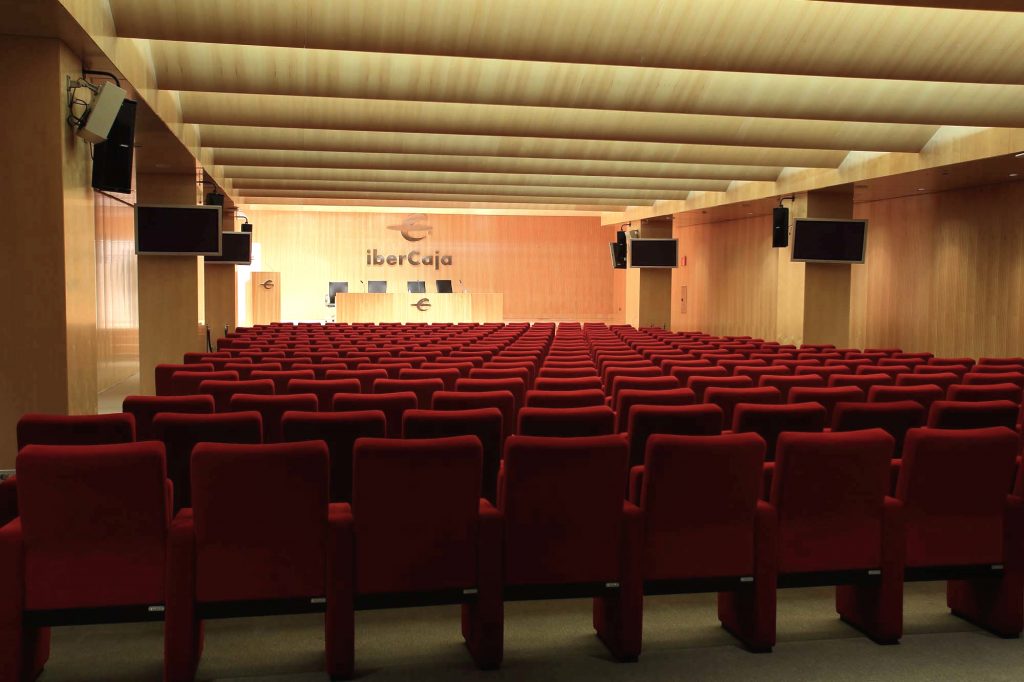PATIO DE LA INFANTA
The Patio de la Infanta is located in the Headquarters of Ibercaja, in Zaragoza, after being bought and restored by this entity. It is considered a jewel of the Aragonese Renaissance art and is a model of courtyards of other important palaces of the time. It belonged to the House of the merchant Gabriel Zaporta (XVI century), located in the street San Jorge and demolished in the year 1903 after a great fire. From the 19th century onwards, this patio will be known as “Patio de la Infanta” in honor of Mª Teresa de Vallabriga, wife of the infant Don Luis de Borbón.
ORIGINS
This jewel of the Aragonese Renaissance dates from between 1549 and 1551,the years in which Gabriel Zaporta, a rich merchant and Aragonese nobleman, redesigned his stately home in Zaragoza. From this mansion, considered to be the first bank to be established in Spain, Zaporta controlled the trade carried out in the city’s commodity exchange and the flow of goods on the trade route of the Eb ro River.
ro River.
Zaporta ordered the construction of this spectacular patio in honour of his wife, Sabina Santángel, on the occasion of their marriage in 1549. From the moment it was built, the patio became a benchmark and model for the Plateresque art of Aragón, and a witness to one of the most splendid golden ages for art and architecture in Zaragoza.
THE TRAVELLING PATIO
Having housed different institutions and businesses during the 19th century, including the Academy of Fine Arts, a school, a music academy, piano factory, printing press and cabinet-making workshop, in 1894 the Casa Zaporta suffered a serious fire that left almost the entire building in ruins. Following various attempts to restore the residence, in 1903 demolition work began and in 1904 the Patio de la Infanta was disassembled and sold to the antique dealer Fernand Schultz, who reconstructed the patio in his home in Paris.

A new life awaited the patio in the French capital, where it served as the highly unusual setting for Schultz’s antiques shop, evoking the admiration of figures such as Goering and Eva Duarte, who were eager to acquire such a fine work.
Finally, and following the skillful negotiations of José María Royo Sinués and Benito Gil Cirez, in 1958 the saviVenungs bank Caja de Ahorros y Monte de Piedad of Zaragoza was able to purchase the patio and transport it back to the Aragonese capital in 1958. Once in Zaragoza, it was erected in the newly opened central headquarters of Ibercaja in 1980, where the patio still stands today.
Apart from the Patio de la Infanta, Ibercaja’s Obra Social also boasts an Exhibition Hall, two conference centers and a multipurpose space hosting important exhibitions, conferences and contests.
Immerse yourself in a magical story. Discover a unique place: a patio where you can hear the whispers of love and passion, separation and sorrow, of fiestas and flattery, sadness and joy. Of kings and gods, of dukes and warriors. This is the Patio de la Infanta: a unique place steeped in history and legends that is only awaiting one thing: for you to come and experience it.
SALÓN RIOJA (RIOJA ROOM)
 • Living space: 315 m²
• Living space: 315 m²
• Capacity: 258 seats
It is suitable for congresses, conferences, video projections, etc.It has a stage (12 m wide, 4 m deep and 3.20 m high), control cabin, video projector and room screens.
Directions
Patio de la Infanta, Ibercaja Headquarter, Calle San Ignacio de Loyola, 16, 50008, Zaragoza, Spain.
